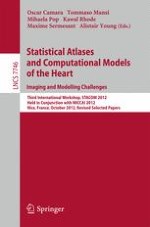
2013 | OriginalPaper | Buchkapitel
Study on Hemodynamics in Patient-Specific Thoracic Aortic Coarctation Model
verfasst von : Wenyu Fu, Aike Qiao
Erschienen in: Statistical Atlases and Computational Models of the Heart. Imaging and Modelling Challenges
Verlag: Springer Berlin Heidelberg
Aktivieren Sie unsere intelligente Suche, um passende Fachinhalte oder Patente zu finden.
Wählen Sie Textabschnitte aus um mit Künstlicher Intelligenz passenden Patente zu finden. powered by
Markieren Sie Textabschnitte, um KI-gestützt weitere passende Inhalte zu finden. powered by
In order to assess the variability in the calculation of the pressure gradient through a moderate thoracic aortic coarctation (MTAC), a 3D finite element model of MTAC was constructed, which includes the ascending aorta, the aortic arch, the descending aorta, and the three large branches (the innominate artery, the left common carotid artery, and the left subclavian artery), as well as with a coarctation in the descending aorta. The surface model of MTAC in STL format was imported into ANSYS ICEM CFD12.1 to generate volume mesh.A finite element model suitable for hemodynamics analysis of patient-specific MTAC was established.Numerical simulation of hemodynamics in this model was performed by means of Computational fluid dynamics (CFD) using ANSYS CFX12.1. The temporal distributions of homodynamic variables such as streamlines, wall pressure, velocity vector and wall shear stress in the arteries were analyzed during a cardiac cycle. The maximum and the average of pressure gradient in a cardiac cycle through a MTAC are 13 mmHg and 2.84 mmHg respectively. The pressure difference between the systolic and the diastolic in a cardiac cycle proximal to the coarctation is about 38 mmHg, which is smaller than the difference between the recorded systolic and diastolic pressures of 115 and 65 mmHg (i.e. the difference is 115-65=50). Similarly, the pressure gradient through the coarctation under exercise conditions could be predicted via modifying the inflow and outflow boundary conditions under resting conditions. CFD techniques make it possible to obtain information (such as pressure when the patient is under exercise condition) which is difficult to get in clinic practice or in experiment based on patient-specific data.